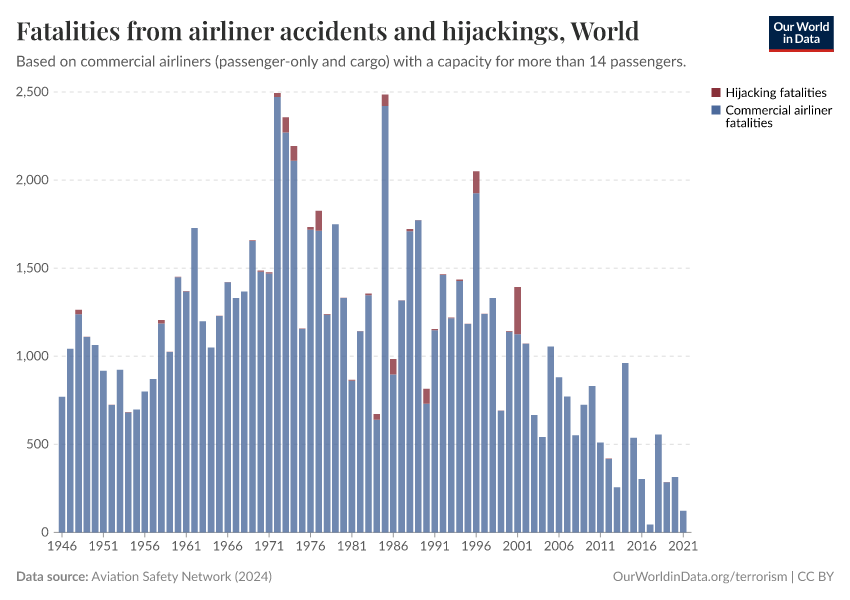Airline hijackings were once common but are very rare today
There have been very few hijackings and almost no fatalities in recent decades.
How often are airlines hijacked?
Airline hijackings are a very visible form of terrorism. The 9/11 attacks in New York were the most prominent example. But whilst hijackings can seem like a modern form of terrorism, they have a long history: in fact, hijackings today are very rare and much less frequent than the past.
Airline hijacking – sometimes termed ‘skyjacking’ – is the unlawful seizure of an aircraft, either by an individual or an organized group. Most commonly, hijackers would demand the pilot fly to a specific location, or sometimes hijackers would attempt to fly the aircraft themselves.
Incidents of hijacking have been around almost as long as human flight itself with suspected hijacks dating as far back as 1919, and the first recorded hijacking in 1931. But they were still relatively rare until the 1950s.

In this chart we see the annual number of hijacking incidents and fatalities globally from 1942 onwards. This data is sourced from the Aviation Safety Network, which provides up-to-date and complete information on airliner accidents across the world. Here we see very few incidents in the 1940s, with a small rise through the 1950s and 1960s. Until 1968, there were never more than 10 incidents in a year.
But from 1968 to 1972, there was a sharp rise in hijackings – particularly in the United States. This is often called the “Golden Age of hijacking” where hijackers would frequently demand to be taken to a specific location (often Cuba) or demand large amounts of money as ransom. Over this 5-year period there were 305 hijackings globally. Most ended in no fatalities: 46 were killed, 25 of which happened in 1972.
The “Golden Age” was brought to an end in 1973 when the Federal Aviation Administration (FAA) in the US introduced rules which required the screening of all passengers and carry-on luggage before boarding passenger aircraft. This is a measure we take for granted today.
Over the period from 1973 until 2001, hijacking incidents across the world were fairly consistent, in the range of around 20 to 40 per year. In most years there were very few fatalities, although these were interspersed with fatal events which would kill tens of passengers.
2001 is the major outlier. Despite there being a relatively small number of events – just 11, which was low by historic standard – the events of 9/11 made it the most fatal. Four airliners were hijacked, two of which were flown into the Twin Towers of the World Trade Center. 2,996 people died as a result of the 9/11 attacks, making it the most fatal terrorist incident in recorded history.
Regulation was quickly tightened. This resulted in a sudden decline in hijacking following the 9/11 attacks, with very few incidents and almost no fatalities. Cockpit doors on many aircraft are now bulletproof and reinforced; security checks are now standard in most countries, including domestic flights (at the time, many countries had no or random checks for domestic travel); and levels of airport screening have been tightened significantly.
They’ve been successful. Fatalities from hijackings are now very rare.
The risk of hijacking in perspective
Many people are worried about flying because of the perceived risk of terrorism. Some may avoid flying completely.
But it’s important to put the risk of hijacking (and flying in general) in perspective. Aviation, especially commercial air travel, is very safe. If we put it in perspective of the number of the number of people flying, in 2017 there were only 0.01 deaths per million passengers: that’s one death per 100 million. This has improved significantly since the 1970s when there was around 5 deaths per million passengers.

Hijacking deaths are then only a very small fraction of the total from aviation. In this chart we see the annual deaths from commercial airliners, and the number specifically from hijackings. This again highlights that hijacking fatalities are rare: with increased safety measures post-2001 there have been almost none.
Cite this work
Our articles and data visualizations rely on work from many different people and organizations. When citing this article, please also cite the underlying data sources. This article can be cited as:
Hannah Ritchie (2017) - “Airline hijackings were once common but are very rare today” Published online at OurWorldinData.org. Retrieved from: 'https://archive.ourworldindata.org/20251125-173858/airline-hijackings-were-once-common-but-are-very-rare-today.html' [Online Resource] (archived on November 25, 2025).BibTeX citation
@article{owid-airline-hijackings-were-once-common-but-are-very-rare-today,
author = {Hannah Ritchie},
title = {Airline hijackings were once common but are very rare today},
journal = {Our World in Data},
year = {2017},
note = {https://archive.ourworldindata.org/20251125-173858/airline-hijackings-were-once-common-but-are-very-rare-today.html}
}Reuse this work freely
All visualizations, data, and code produced by Our World in Data are completely open access under the Creative Commons BY license. You have the permission to use, distribute, and reproduce these in any medium, provided the source and authors are credited.
The data produced by third parties and made available by Our World in Data is subject to the license terms from the original third-party authors. We will always indicate the original source of the data in our documentation, so you should always check the license of any such third-party data before use and redistribution.
All of our charts can be embedded in any site.